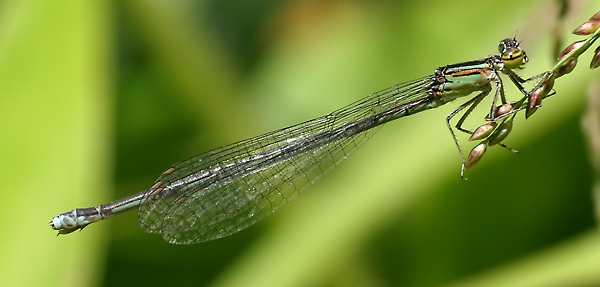Classification
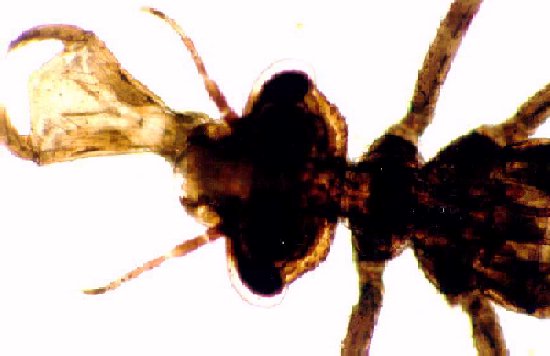
Damselflies
belong to the order Odonata (“o do NAY ta”), and Odonata comes
from the Greek word odon (tooth) which refers to the
damselflies’ mandibles (Hyperlink to adaptations) or the shape
of their abdomen.
Domain - Eukarya
Kingdom - Animalia
Phylum - Arthropoda
Class - Hexapoda (Insecta)
Order - Odonata
Suborder - Zygoptera
Families - Calopterigidae, Lestidae, Protoneuridae,
Coenagrionidae
Genus and Species - dependent on Family
If you find a damselfly and want to classify it, then click here!

Click the picture to view a phylogenetic tree for domain,
kingdom, phylum, and class classification for Zygoptera.

Click this picture to see the phylogenetic tree for class,
order, suborder, and families of Zygoptera.
I created these phylogenetic trees by formatting tables in Microsoft Word.
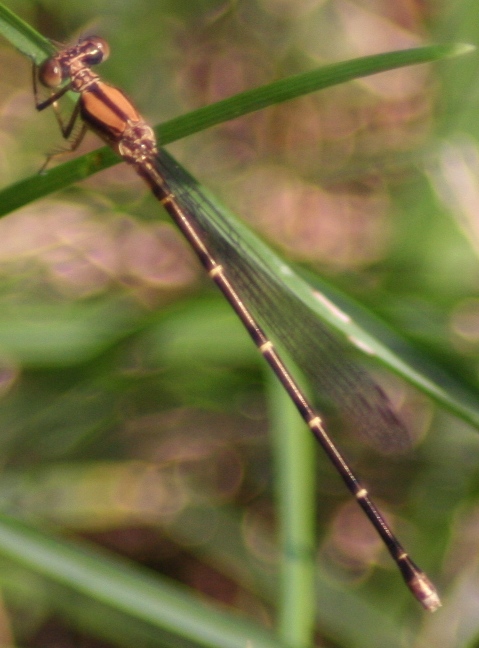 Domain: Eukarya
Domain: Eukarya
Damselflies belong in the domain Eukarya which comes from two terms, “eu” meaning “true” and “karya” which means “nucleus.” Damselflies are classified here because their cells have true nuclei (genetic material) and membrane-bound organelles.
Kingdom: Animalia
Zygoptera are part of the kingdom Animalia because they are heterotrophic (define), lack a cell wall, and are able to move during at least one life cycle.
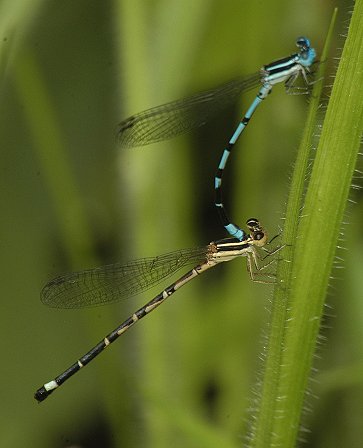 Phylum: Arthropoda
Phylum: Arthropoda
Zygoptera are in the phylum Arthropoda because they have a chitinous exoskeleton, are segmented, grow by molting, and use paired/joint appendages.
Class: Hexapoda (Insecta)
Zygoptera belong to the class Insecta because they have compound eyes, three pairs of legs, and go through metamorphosis during the life cycle.
Order: Odonata
Zygoptera are part of the order Odonata because they have two pairs of wings, 6 legs suited for prey capturing, and have elaborate mating processes. Odonata use a mandible to capture and chew their prey. During reproduction, Odonata males and females fly latched together.
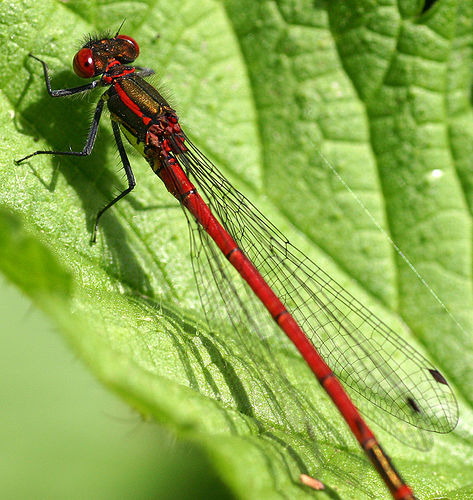 Suborder: Zygoptera
Suborder: Zygoptera
Zygoptera are smaller than the other suborder Anisoptera with a small, cylindrical abdomen. Most Zygoptera hold their wings up, over their body instead of out to the sides like Anisoptera, and Zygoptera eyes sit toward the sides of the head instead of on top.
Keep reading to investigate three of the Zygoptera families!
Narrow-winged Damselflies (Family: Coenagrionidae)
Pronunciation: seen-ag-gree-ON-ni-dee
The Coenagrionidae family is the most common damselfly
family, commonly now as Pond Damsels because they reside near
ponds or slowly moving streams. These particular
damselflies are small and fragile in appearance with
stalked wings. Males are us ually black and blue or green
while females are black and tan; however, females may go through
two color changes, including a male-like pattern and a duller
pattern. Species names generally stem from their
coloration (i.e. Violet Tails and Bluets).
ually black and blue or green
while females are black and tan; however, females may go through
two color changes, including a male-like pattern and a duller
pattern. Species names generally stem from their
coloration (i.e. Violet Tails and Bluets).
Three groups comprise Coenagrionidae: Argia (dancers), Enallagma (American Bluets), and Ischnura (forktails).
Argia (dancers): There are over 100 species in this genus, and they are an active and alert bunch. These damsels are usually blue and purple, but two species are either white ash or soot colored; Agria species have a black stripe running along their back with lighter stripes bordering it, but there are many variations in this color scheme. Members of this genus like to perch on flat surfaces, including rock walls or the ground, and while they perch, they “clap” their wings together. To determine if the damselfly belongs to Agria, look at the long spurs on the legs.
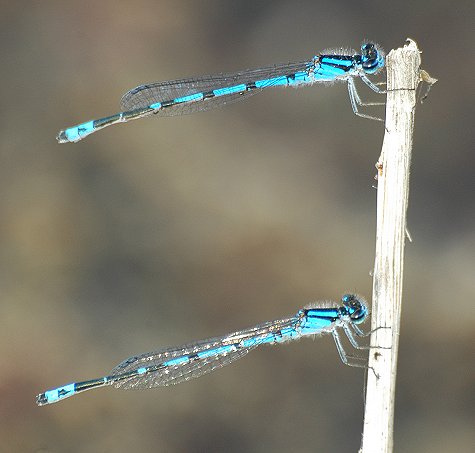 Enallagma
(American Bluets): This is the most common genus with 40 species
covering much of the northern hemisphere. Adults
thrive from late May through September, but their naiads can
live up to 3 years in their aquatic habitats. It is easy
to mistake Bluets for other species because their colorations
vary widely; males are a light blue than the females with black
spots that look like stripes, and females are usually a dark
blue with large black spots than the males.
Enallagma
(American Bluets): This is the most common genus with 40 species
covering much of the northern hemisphere. Adults
thrive from late May through September, but their naiads can
live up to 3 years in their aquatic habitats. It is easy
to mistake Bluets for other species because their colorations
vary widely; males are a light blue than the females with black
spots that look like stripes, and females are usually a dark
blue with large black spots than the males.
Ischnura (Forktails): Damselflies in this genus are much
smaller that Enallagma, but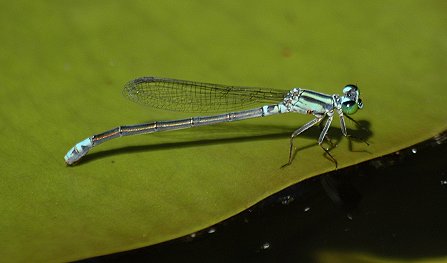 they live in similar habitats to them. Males are mostly
black with blue or green sections near the backend, and they
have green stripes on their sides near the head. Females,
on the other hand, are orange or brown with a variety of color
schemes. Ischnura are commonly called Forktails because
the last segment of their abdomen is split.
they live in similar habitats to them. Males are mostly
black with blue or green sections near the backend, and they
have green stripes on their sides near the head. Females,
on the other hand, are orange or brown with a variety of color
schemes. Ischnura are commonly called Forktails because
the last segment of their abdomen is split.
Broad-winged Damselflies (Family: Calopterygidae)
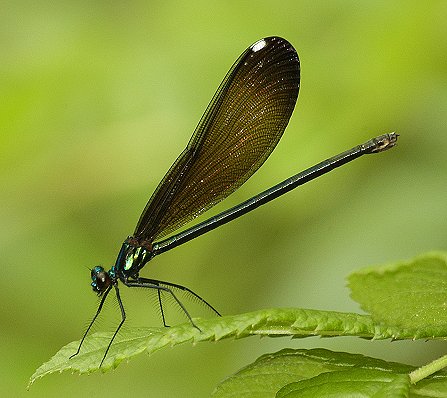 Calopterygidae
damselflies are large, measuring in at 2 inches long; they are
commonly known as Broad-Winged Damselflies, but in the past,
people called them the “Birds of Paradise amongst Odonata.”
The bright, metallic colors on male and some female wings were
probably the basis for this name. The wing color patterns
can be similar between males and females, so it is easier to
distinguish between the sexes based on eye color; males have
black eyes while females have brown eyes.
Calopterygidae
damselflies are large, measuring in at 2 inches long; they are
commonly known as Broad-Winged Damselflies, but in the past,
people called them the “Birds of Paradise amongst Odonata.”
The bright, metallic colors on male and some female wings were
probably the basis for this name. The wing color patterns
can be similar between males and females, so it is easier to
distinguish between the sexes based on eye color; males have
black eyes while females have brown eyes.
This Zygoptera family displays unique mating rituals and territorial behavior. Males hover and bounce in front of the female, and the female damselfly accepts or rejects the male. Once the female begins ovipositing, the male perches near her, exhibiting territorial behaviors. In the adult stage, Calopterygidae damselflies rarely stray far away from the ponds and streams where they completed their naiad stage. While flying, these damselflies appear to skip because as their wings hesitate at the top of each stroke as they beat 16 times per second.
Spread-winged Damselflies (Family: Lestidae)
Damselflies belonging to the Lestidae family are also called
Spread-Winged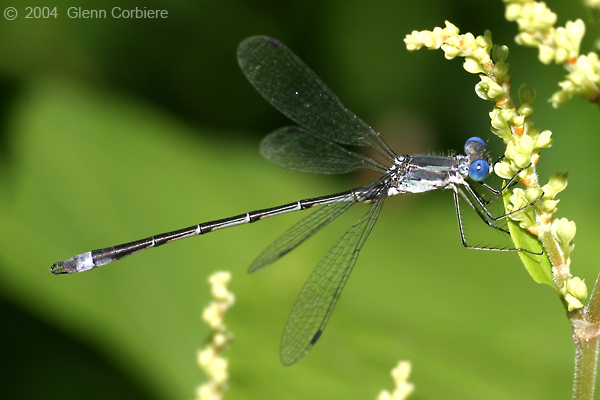 Damselflies because they hold their wings out to the sides when
they are not flying; this characteristic makes Spread-Winged
Damselflies look like dragonflies, but their long, slender
bodies differentiate them as damselflies. This Zygoptera
family rest vertically on stems and grasses while they hold
their wings out; these damselflies reside near ponds and swamps
and are most prevalent during late summer.
Damselflies because they hold their wings out to the sides when
they are not flying; this characteristic makes Spread-Winged
Damselflies look like dragonflies, but their long, slender
bodies differentiate them as damselflies. This Zygoptera
family rest vertically on stems and grasses while they hold
their wings out; these damselflies reside near ponds and swamps
and are most prevalent during late summer.
Lestidae damselflies have clear wings which narrow until they become stalks, earning them another common name, Stalk-Winged. Their dark-wing spots are elongated or rectangular, are larger than other damselfly families, and are metallic blue or green.
Identification Tips
Entomologists disagree on the proper methods for identifying
damselfly species. Some species are difficult to classify
because they are not properly recorded upon capture; this
occurred when entomologists neglected other families in Zygoptera
while they investigated Coenagrionidae, but the families that
they focus on need to be revisited to base classification on new
documentation.
These are ways to reduce the likelihood of problems during
the identification process:
· Do not rely on only the naiad’s morphology; look at the
adult’s features.
· Illustrate
the subject’s genitalia.
· Describe
structures of species similar to the subject.
· Use other
authors’ descriptions as a base for new ones.
When describing a specimen, scientists must include
information on the following points in order to properly record
the damselfly:
· Male and female genitalia and structures used for mating from many views
· Wing
venation, markings, and coloration especially with sexual
dimorphism
· Lengths for
head, wings, abdomen, appendages, and total body
· Adult and naiad head, wings, legs, and spines
Now you know what they look like and how to identify them, but where do they live? Head over to the habitat page to see if they live by you!
